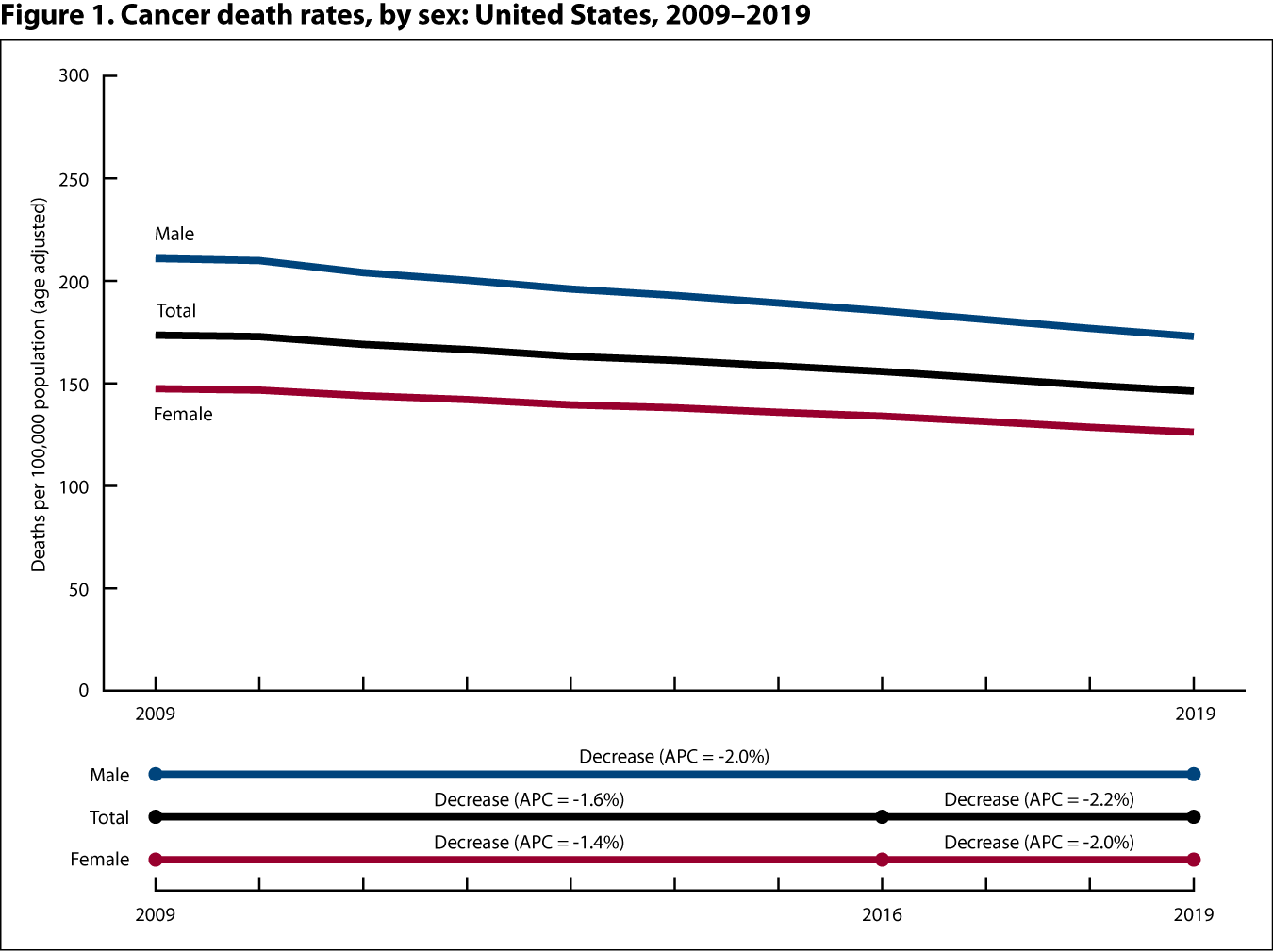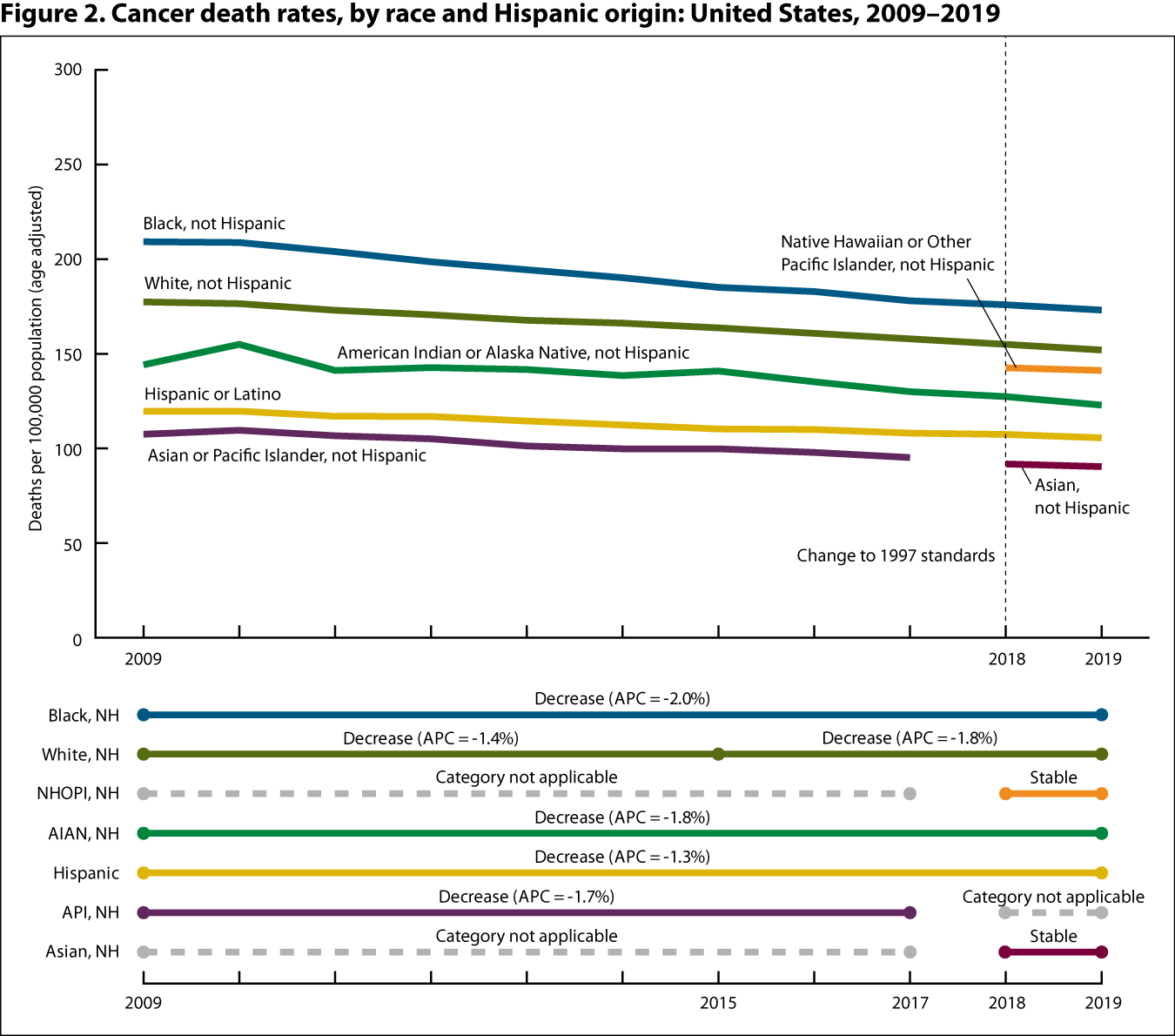Cancer Deaths
The content on this page was last updated in June 2023. More recent estimates and visualizations may be available from the NCHS Data Query System.
Cancer has been one of the top two leading causes of death for more than 75 years (1,2). Deaths from cancer have decreased over the past 3 decades (Table SlctMort), reflecting factors such as the decrease in cigarette smoking and increased use of cancer screening tests (3).
Key Findings

Age-adjusted cancer deaths per 100,000 population decreased from 173.5 in 2009 to 155.8 in 2016, and then decreased at a faster rate to 146.2 in 2019. A total of 599,601 people died of cancer in 2019. See Featured Charts for additional analysis.
SOURCE: National Center for Health Statistics, National Vital Statistics System, Mortality. See Sources and Definitions, National Vital Statistics System (NVSS) and Health, United States, 2020–2021 Table SlctMort.
Over the past decade, males were 1.4 times more likely to die from cancer than females.

NOTE: APC is annual percent change.
SOURCE: National Center for Health Statistics, National Vital Statistics System, Mortality. See Sources and Definitions, National Vital Statistics System (NVSS) and Health, United States, 2020–2021 Table SlctMort.
- From 2009 to 2019, the age-adjusted cancer death rate was higher for males than for females.
- Among males, age-adjusted cancer deaths per 100,000 population decreased from 210.9 in 2009 to 172.9 in 2019.
- Among females, age-adjusted cancer deaths per 100,000 population decreased from 147.4 in 2009 to 134.0 in 2016, and then decreased at a faster rate to 126.2 in 2019.
Cancer death rates decreased for all race and Hispanic-origin groups during the period, but differences by group remain.

NOTES: NH is non-Hispanic origin. NHOPI is Native Hawaiian or Other Pacific Islander. AIAN is American Indian or Alaska Native. API is Asian or Pacific Islander. APC is annual percent change. “Stable” refers to no statistically significant trend during the period.
SOURCE: National Center for Health Statistics, National Vital Statistics System, Mortality. See Sources and Definitions, National Vital Statistics System (NVSS) and Health, United States, 2020–2021 Table SlctMort.
- During the period, the age-adjusted cancer death rates decreased for all race and Hispanic-origin groups for whom trend testing was possible.
- From 2009 to 2019, non-Hispanic Black people had the highest age-adjusted cancer death rate, while from 2009 to 2017, non-Hispanic Asian or Pacific Islander people had the lowest. In 2018 and 2019, non-Hispanic Asian people had the lowest age-adjusted cancer death rates.
- In 2019, age-adjusted cancer deaths per 100,000 population were 173.1 among non-Hispanic Black, 152.0 among non-Hispanic White, 141.2 among non-Hispanic Native Hawaiian or Other Pacific Islander, 122.9 among non-Hispanic American Indian or Alaska Native, 105.6 among Hispanic or Latino, and 90.4 among non-Hispanic Asian people.
Download the data
Age-adjusted death rates for selected causes of death, by sex, race, and Hispanic origin: United States, selected years 1950–2019
SOURCE: National Center for Health Statistics, National Vital Statistics System, Mortality.
Life expectancy at birth, age 65, and age 75, by sex, race, and Hispanic origin: United States, selected years 1900–2019
SOURCE: National Center for Health Statistics, National Vital Statistics System, Mortality.
Leading causes of death and numbers of deaths, by sex, race, and Hispanic origin: United States, 1980 and 2019
SOURCE: National Center for Health Statistics, National Vital Statistics System, Mortality.
Leading causes of death and numbers of deaths, by age: United States, 1980 and 2019
SOURCE: National Center for Health Statistics, National Vital Statistics System, Mortality.
- Cancer deaths: Identified using International Classification of Diseases, 10th Revision (ICD–10) underlying cause-of-death codes for malignant neoplasms, C00–C97. See Sources and Definitions, Cause of death; International Classification of Diseases (ICD).
- Hispanic origin: People of Hispanic origin may be of any race. See Sources and Definitions, Hispanic origin.
- Leading causes of death: Ranked according to the number of deaths. See Sources and Definitions, Cause of death; Cause-of-death ranking.
- Race: Starting with 2018 data, estimates are presented according to the 1997 Office of Management and Budget’s “Revisions to the Standards for the Classification of Federal Data on Race and Ethnicity,” which includes separating the Asian or Pacific Islander classification into two groups: Asian and Native Hawaiian or Other Pacific Islander. Single-race estimates for 2018 and beyond are not completely comparable with bridged-race estimates for earlier years, particularly for smaller race categories. See Sources and Definitions, Race.
- Hoyert DL. 75 years of mortality in the United States, 1935–2010. NCHS Data Brief, no 88. Hyattsville, MD: National Center for Health Statistics. 2012.
- Kochanek KD, Xu JQ, Arias E. Mortality in the United States, 2019. NCHS Data Brief, no 395. Hyattsville, MD: National Center for Health Statistics. 2020.
- Centers for Disease Control and Prevention. An update on cancer deaths in the United States. Atlanta, GA. 2021. Available from: https://www.cdc.gov/cancer/dcpc/research/update-on-cancer-deaths/index.htm.


